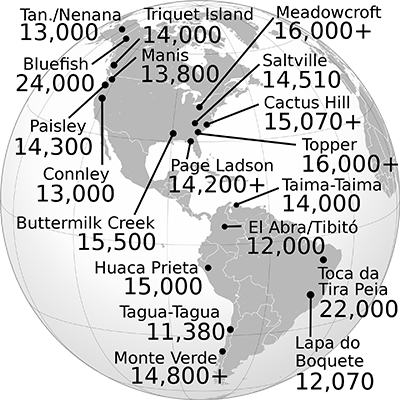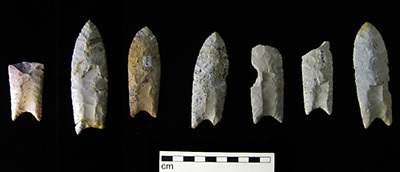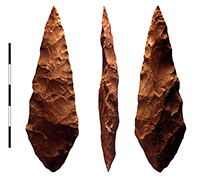“When Is An Hypothesis Not An Hypothesis? When it's the Solutrean Hypothesis.” by Michael Z. Williamson
I’ve done a lot of research on the Upper Paleolithic recently, for my novels A Long Time Until Now, That Was Now, This is Then, and for an upcoming third.
I have several friends enamored of this hypothesis, and I’m not sure why. Pretty much no credible researchers like it, and I find it utterly uncompelling on every level. I looked at it again after a recent debate. I like it less every time I look at it.
It summarizes like this: The Solutrean Culture of the area that is now France and Spain, (22,000-17,000 BP) used overshot flaking to shape their flint tools, and as of the proposal date, were the first culture to do so. Clovis points (13,200 BP) of the Americas also used overshot flaking. Lots of Clovis points are found in the Eastern U.S., therefore, the Solutreans must have travelled across the Atlantic, and settled there 3800 years later with the same technology. In support, it is argued that the oldest settlement sites in the Americas are in the Eastern U.S.
That's it.
So, starting at the beginning:
The oldest probable human occupation in the Americas is 24,000 BP, in the Yukon. There are numerous confirmed finds older than the Clovis, all the way down to Chile. There are speculated and potential sites as far back as 50,000 BP, but those are not confirmed. Still, there were plenty of people in the Americas before the Clovis Culture (more accurately, it's a tradition or industry, since we find it all over and they very well were entirely different cultures with different languages, just using the same technology, much like Japan, the U.S. and Germany all use the same steels and machine tools to make cars).
We find more settlements in the east (and the ones my friends referenced are pre-Clovis). But settlements require both terrain and climate to support them. Finds from nomadic peoples are hard to source, because they are widely dispersed on terrain that's not used much. So the number of finds is less significant than the contents.
Meadowcroft Rockshelter includes: "other lanceolate points, small prismatic blades, and small polyhedral blade cores have been recovered. According to Adovasio et al, this complex has a Eurasiatic and Siberian appearance." And predate the Clovis points by 3000 years, but don't resemble the 1000 year older, or possibly contemporary, Solutrean points.
Topper Site predates Clovis, and bears no resemblance to Solutrean sites that are only about 1000 years older.
Cactus Hill dates positively to at least 15,000 BP, possibly 16,000-20,000, but that is not confirmed. It contains two overshot-flaked partial (broken) points that may be proto-Clovis. This is the primary basis for the claims of the Solutrean Hypothesis. Two broken pieces of points that are admitted to not be Solutrean, not Clovis, but possibly similar in some ways to both. Best case. Worst case, they're flaked points that bear no similarity to Solutrean Points at all.

Source: Wikipedia.org
The major sites are evenly split between east and west North America, with the west averaging older, but not relevantly so. This suggests a quite thorough occupation of the continent. Actual coastlines and the Great Lakes and Canadian Shield regions suffered much change in shape due to rising sea levels (narrower in the west), the melt and runoff of Glacial Lake Agassiz, and other factors. It's going to be harder to find evidence in those locations.
Interestingly, the later Cascade Points of the Pacific Northwest bear more of a resemblance to Solutrean Points than Clovis Points and support the reasonable deduction that there are only so many ways to shape a stone point, so similarities should be expected.
The theory of a land bridge in Beringia is well-supported by numerous finds. There's a current dispute over an ice-free corridor in the right timeframe for Clovis occupation, but it's not a problem for the confirmed earlier settlements. It also has no bearing on coastal migration, and most of those sites are under water now, though some are starting to be located and explored, and that will probably settle this permanently.
The Clovis industry shows up when it does and becomes widespread across the continent. It's a very effective, efficient, and beautiful way of making lithic points.
So, accepted as fact: There were peoples in the Americas for at least 5,000 years before Clovis, probably 11,000, and Clovis were not the first ones we know of to overshot flake.
Solutreans were the first Europeans we know of to overshot flake.
And now, an archaeological discovery in 2010 in Blombos Cave, South Africa, "places the use of pressure flaking by early humans to make stone tools back to 73,000 BCE, 55,000 years earlier than previously accepted." Now, pressure flaking is a root to overshot flaking, but it arose independently in Africa before it did in Europe and the Americas.
So, that's three disparate cultures using similar techniques. Two are absolutely independent developments. There's no reason the third isn't. To claim that Americans couldn't have figured out a better way to shape stone is as ridiculous as the claims that they couldn't figure out how to stack small rocks on big ones to make pyramids, so the Egyptians must have settled Central America. Yes, some "researchers" claim that.
The Solutrean technique also seems to have gone out of fashion in Europe, and was replaced by careful pressure flaking, then by polishing, before bronze appears. In the Americas, various flaking technologies continued to evolve to a fine art due to isolation. There are similarities of technique weaving in and out, but all evidence is that the technologies were shared with nearby groups and dispersed, also depending on the type of material being worked.
Then, these are Solutrean points:
These are Clovis points:
Which are different, fluted, and in fact, more sophisticated than Solutrean points.
This brings is to "Could have, but didn't need to have" as far as the vague similarity of tools. The Solutrean Hypothesis isn't needed to explain this "similarity" because not only is it not, but there are only so many ways to shape flint. Much like there were probably three independent developments of iron, and at least three of agriculture, and several of bronze.
Except "the oldest Clovis site in North America is believed to be El Fin del Mundo in northwestern Sonora, Mexico, discovered during a 2007 survey. It features occupation dating around 13,390 calibrated years BP. In 2011, remains of gomphotheres were found; the evidence suggests that humans did, in fact, kill two of them there. Also, the Aubrey site in Denton County, Texas, produced an almost identical radiocarbon date."
Shortly thereafter, we find the Clovis tool industry in Washington State.
In fact, the African points look closer to Solutrean. But I don't think anyone would suggest there were direct lineal ties between them, even though they can be reached overland.
So as far as similarity of flint tools: There isn't. Done. All three cultures developed these basic techniques independently.
The Solutreans had a lot of cave art, carvings, even some bone instruments. The Eastern cultures of the Clovis industry, so far as we know, did not have comparable art or artifacts. When this issue was raised, in fact, the proponents replied: "Bradley and Stanford contend that it was 'a very specific subset of the Solutrean who formed the parent group that adapted to a maritime environment and eventually made it across the north Atlantic ice-front to colonize the east coast of the Americas' and that this group may not have shared all Solutrean cultural traits."
So which traits did they keep? Because we've debunked the claim of having the same tool set. They didn't use similar art, similar shelters, or instruments. At least not that we've found. You can't claim to share traits not in evidence, and so far, there's no evidence of ANY shared traits. Well, they both hunted meat, I guess.
Let's step back to the primary issue here. Are there genetic links? Because if a bunch of European Cro-Magnon came here, we should see their haplogroups.
Here’s a Clovis infant related to all American natives, and to many Asian natives, including the Yeniseians, currently believed to be descended from the ancestors of the Americans. What he is not related to are Europeans. He's Clovis era, and he is out west. Where the Clovis tool set seems to have originated.
The only European haplogroups we find in the east are post 1400, when various explorers and sailors were making land, and making native women.
Now, this doesn't disprove that Europeans came here and their lines died out entirely. But we'd need to find said haplogroup in a burial site, and we haven't. Nor is it likely. Europeans still carry some small percentage of Neanderthal DNA 40,000 years later, the result of (estimated) six surviving cross-breedings. (Many more may have happened. Only six lines have survived to the present.) So had these Solutreans come here, we would absolutely expect to find some genetic residue. We do not.
Linguistics are almost impossible to analyze at this distance. However, there is this which discusses the same general timeframe. The consensus is it's probably impossible to prove, but feasible. This hypothetically ties languages between those two continents. There's nothing so far to suggest any proto-European influence in native languages. Note that I include this just to cover all bases.
So at this point: Zero linguistic, genetic, aesthetic, or technical connection in evidence between Europe and the Americas at that time, and the Clovis industry started on the far side of the continent from Europe (per our current findings). And it started 3500 years later. Which means it's not the same culture. (This also irks me when modern natives insist that some find as old as Anzick has to be buried with "tribal traditions." That would be like me insisting a Neolithic find in the UK be given a "Christian burial." A Baptist one at that. There's no cultural relationship present.)
Nothing.
Now let's look at the hypothetical method by which these Solutreans arrived here.
Well, there isn't one. Perhaps they moved onto the ice sheets across the North Atlantic and eventually came off them in the Americas and traveled halfway down the coast and moved inland to share a dissimilar technology that first appears on the far side of the continent.
But while we're at it:
The Solutreans were the end of the Gravettian era (though used a different toolset and industry) in Europe. They lived in a relatively temperate Southern France and Iberia. This is a nice place to be during an ice age. It's a nice place to be now.
Why would they move north, onto the ice?
"Population pressure"?
Land ice is easier and safer to live on than sea ice. We have zero evidence of anyone doing so. I point that out because obviously no evidence would remain from sea ice. It would be at the bottom of the Atlantic. If it existed. Which seems very unlikely because no cultures we know of ever lived on the ice. They might hunt, fish and travel there, but they lived on solid land. These alleged displaced people would be better off moving inland, or south. Even into the North African desert would be better than the ice.
The problems with living on sea ice should be obvious:
- Risk of falling through cracks and losing a tent or a village. You better hope it stays really cold.
- Really cold is harder to survive and requires heat sources.
- Pack ice has very limited building and boatbuilding materials—bone and skin only.
- Pack ice has very limited food—fish, some marine mammals.
- Pack ice has very limited fuel for the previously mentioned heat sources—whale or seal oil, and not a lot of it.
- There’s almost no possible way to make a wick to burn the oil for heat or cooking. You could use a skull as a lamp base, but a wick? You need an easily flammable, porous substance. Moss, tow, fungus were all used. What do you use on pack ice? There's nothing. No fire.
- Once you're on the ice, all your tools are going to be made of bone. The Dorset, Thule, Inuit and Athabaskans all did or do this.
But guess what?
They didn’t know how to flake flint.
So, the hypothesis is that some Solutreans move onto the ice, doing something that makes no sense, is virtually guaranteed to kill them all in a matter of weeks, magically survive, and spend 3000-4000 years surviving in a worse environment than any we've ever seen humans live in, working their way across the ice. . . .
Also, they'd have passed over the Faeroe Islands, Iceland, Greenland, Baffin Island, Labrador and Newfoundland, and somehow didn't leave any evidence of their passage, or this awesome flint-shaping technique there.
And, as noted, for the 3000-4000 years they're on the ice . . . no flint to shape. No written records to document the technique. But somehow, leaving Europe in 17,000 or earlier, they arrive in the Americas around 13,200 and remember how to pressure flake flint . . . in Sonora, Mexico. In a totally different shape.
Vs: A founder population from Asia, east of the Yenisei River and north of Lake Baikal, moved onto existing land either coastal or inland or both, and spread into the continent, leaving genetic, material, and potential linguistic evidence, using well-established technology we can observe in both places. For example: "Stemmed points are a lithic technology distinct from Beringian and Clovis types. They have a distribution ranging from coastal east Asia to the Pacific coast of South America. The emergence of stemmed points has been traced to Korea during the upper Paleolithic. The origin and distribution of stemmed points have been interpreted as a cultural marker related to a source population from coastal east Asia."
I think we're done here.
I guess the only question I have is why this pile of crap is considered an "Hypothesis."
Look, when researching my last fiction work, I came up with what some professional paleanthropolgists say is a valid hypothesis for the development of leather tanning. I'll quote:
"The chamber pot in the lodge is a hole lined with a hide. They close up the hide in the morning and dump it out, then rinse it. Hide plus fat plus piss equals tanning. Anything they didn't scrape fully would wind up tanned, and be very supple wet, very hard when dry. Once you know that, you have leather. Then when you use it as a windbreak or cover, the smoke colors and softens it."
Provable? Not easily. Few organic remains survive for tens of thousands of years. Does it explain all the facts in evidence? Yes. I guess I'm about as close as Trombetti was with the Yeniseian-Na Dene languages. What I came up with works, is probably unprovable. But, it's simple and it works. I'm good with that.
Now, I'm not an academic, and don't have an institution to help promulgate the idea, but I don't really care. If they ever prove it, cool. If not, it fits what we know of leather.
But I'd certainly be embarrassed if my fiction involved fantasy Europeans traveling across ice to America to share nothing. So why did anyone in the field give this the first bit of consideration? It's not even an hypothesis. As the basis for a 1940s fantasy setting, it's about right. But there's literally nothing about it that can't be explained more easily as immigration in the west, and it has literally supporting zero facts other than "this stone point looks sort of like this other stone point if you squint really hard and haven't actually done any flint shaping."
And as far as the 1940s, I’ve found discussion debunking a previous presentation of a variation of this hypothesis, that the north Asiatics were the progenitors of the Solutrean industry, dating to 1939. It wasn’t a new idea, and it wasn’t credible then.
I guess we need to keep the complete fails around to avoid repeating them.
AFTERWORD: One of the groups who love this hypothesis are a subsect of white nationalists who'd love for some irrelevant reason to prove early settlers were European. They did the same when Kennewick Man had some genetic links to the Caucasus region, meaning he had ancestors who were geographically Caucasian, which not the same as being European or White, especially not 9000 years ago. Which is 8000-15,000 years after previous founder populations anyway. I am not at all implicating my friends with these groups, but those groups absolutely adore and insist on these unfactual claims. But quite a few commenters have asked the leading question of, “Who taught the (early Native Americans) to do it?”
The base assumption here, as noted before, is that the paleoIndians couldn’t develop technologies of their own, when they provably did, and the assumption speaks volumes.
Copyright © 2021 Michael Z. Williamson
Michael Z. Williamson is retired military, having served twenty-five years in the U.S. Army and the U.S. Air Force. He has consulted on military matters, weapons and disaster preparedness for Discovery Channel and Outdoor Channel productions and is Editor-at-Large for Survivalblog, with 300K weekly readers. His novels A Long Time Until Now and That Was Now, This is Then make use of his extensive research into the Paleolithic era.






